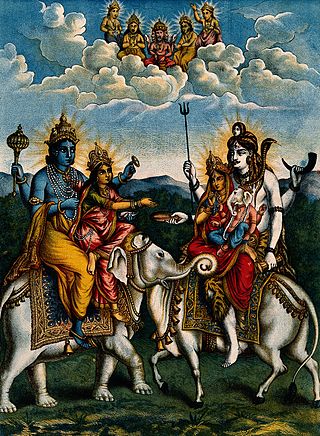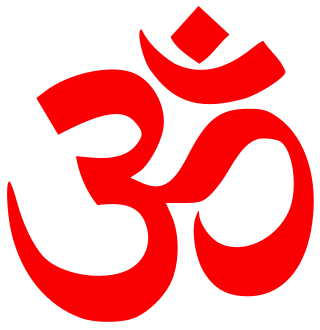Maya, literally "illusion" or "magic", has multiple meanings in Indian philosophies depending on the context. In later Vedic texts, māyā connotes a "magic show, an illusion where things appear to be present but are not what they seem"; the principle which shows "attributeless Absolute" as having "attributes". Māyā also connotes that which "is constantly changing and thus is spiritually unreal", and therefore "conceals the true character of spiritual reality".
Ātman is a Sanskrit word for the true or eternal Self or the self-existent essence or impersonal witness-consciousness within each individual. Atman is conceptually different from Jīvātman, which persists across multiple bodies and lifetimes. Some schools of Indian philosophy regard the Ātman as distinct from the material or mortal ego (Ahankara), the emotional aspect of the mind (Citta), and existence in an embodied form (Prakṛti). The term is often translated as soul, but is better translated as "Self", as it solely refers to pure consciousness or witness-consciousness, beyond identification with phenomena. In order to attain moksha (liberation), a human being must acquire self-knowledge.
Moksha, also called vimoksha, vimukti, and mukti, is a term in Jainism, Buddhism, Hinduism, and Sikhism for various forms of emancipation, liberation, nirvana, or release. In its soteriological and eschatological senses, it refers to freedom from saṃsāra, the cycle of death and rebirth. In its epistemological and psychological senses, moksha is freedom from ignorance: self-realization, self-actualization and self-knowledge.
Hindu philosophy or Vedic philosophy is the set of philosophical systems that developed in tandem with the first Hindu religious traditions during the iron and classical ages of India. In Indian philosophy, of which Hindu philosophy is a prominent subset, the word used for philosophy is Darshana, from the Sanskrit root 'दृश' meaning 'to see, to experience'.

Indian philosophy consists of philosophical traditions of the Indian subcontinent. The philosophies are often called darśana meaning, "to see" or "looking at." Ānvīkṣikī means “critical inquiry” or “investigation." Unlike darśana, ānvīkṣikī was used to refer to Indian philosophies by classical Indian philosophers, such as Chanakya in the Arthaśāstra.
Nondualism includes a number of philosophical and spiritual traditions that emphasize the absence of fundamental duality or separation in existence. This viewpoint questions the boundaries conventionally imposed between self and other, mind and body, observer and observed, and other dichotomies that shape our perception of reality. As a field of study, nondualism delves into the concept of nonduality and the state of nondual awareness, encompassing a diverse array of interpretations, not limited to a particular cultural or religious context; instead, nondualism emerges as a central teaching across various belief systems, inviting individuals to examine reality beyond the confines of dualistic thinking.

Jnana yoga, also known as the jnanamarga, is one of the three classical paths (margas) for moksha (liberation) in the Bhagavad Gita, which emphasizes the "path of knowledge", also known as the "path of self-realization". The other two are karma yoga and bhakti yoga. Modern interpretations of Hindu texts have yielded systems, techniques and formulations such as raja yoga and kriya yoga.
Saguna brahman is a concept of ultimate reality in Hinduism, close to the concept of immanence, the manifested divine presence.

Ishvara is a concept in Hinduism, with a wide range of meanings that depend on the era and the school of Hinduism. In ancient texts of Hindu philosophy, depending on the context, Ishvara can mean supreme Self, ruler, lord, king, queen or husband. In medieval era Hindu texts, depending on the school of Hinduism, Ishvara means God, Supreme Being, personal God, or special Self. In Shaivism, Ishvara is an epithet of Shiva. In Vaishnavism it is synonymous with Vishnu, like in his epithet of Venkateswara. In traditional Bhakti movements, Ishvara is one or more deities of an individual's preference (Iṣṭa-devatā) from Hinduism's polytheistic canon of deities. In modern-day sectarian movements such as Arya Samaj and Brahmoism, Ishvara takes the form of a monotheistic God. In the Yoga school of Hinduism, it is any "personal deity" or "spiritual inspiration". In Advaita Vedanta, Ishvara is the manifested form of Brahman.
A jīvanmukta, literally meaning 'liberated while living', is a person who, in the Jain and Vedānta philosophy, has gained complete self-knowledge and self-realisation and attained kaivalya (enlightenment) or moksha (liberation), thus is liberated while living and not yet dead. The jivanmukt being is termed as sayogi-kevali or Arihant in Jainism. The state is the aim of moksha in Vedānta, Yoga and other schools of Hinduism, and it is referred to as jīvanmukti.
The following list consists of notable concepts that are derived from Hindu culture and associated cultures’ traditions, which are expressed as words in Sanskrit or other Indic languages and Dravidian languages. The main purpose of this list is to disambiguate multiple spellings, to make note of spellings no longer in use for these concepts, to define the concept in one or two lines, to make it easy for one to find and pin down specific concepts, and to provide a guide to unique concepts of Hinduism all in one place.

The Mahāvākyas are "The Great Sayings" of the Upanishads, as characterized by the Advaita school of Vedanta with mahā meaning great and vākya, a sentence. Most commonly, Mahāvākyas are considered four in number,

In Hinduism, Brahman connotes the highest universal principle, the Ultimate Reality of the universe. In major schools of Hindu philosophy, it is the non-physical, efficient, formal and final cause of all that exists. It is the pervasive, infinite, eternal truth, consciousness and bliss which does not change, yet is the cause of all changes. Brahman as a metaphysical concept refers to the single binding unity behind diversity in all that exists.
This is a list of articles in Eastern philosophy.

Ānanda literally means bliss or happiness. In the Hindu Vedas, Upanishads and Bhagavad gita, ānanda signifies eternal bliss which accompanies the ending of the rebirth cycle. Those who renounce the fruits of their actions and submit themselves completely to the divine will, arrive at the final termination of the cyclical life process (saṃsāra) to enjoy eternal bliss (ānanda) in perfect union with the godhead. The tradition of seeking union with God through loving commitment is referred to as bhakti, or devotion.
In Advaita Vedanta and Jnana Yoga Nididhyasana is profound and repeated meditation on the mahavakyas, great Upanishadic statements such as "That art Thou", to realize the identity of Atman and Brahman. It is the fourth step in the training of a sisya (disciple), consisting of preparatory practices, listening to the teachings as contained in the sruti, reflection on the teachings, and nididhyasana.
Vidya figures prominently in all texts pertaining to Indian philosophy – meaning science, learning, knowledge, and scholarship. Most importantly, it refers to valid knowledge, which cannot be contradicted, and true knowledge, which is the intuitively-gained knowledge of the self. Vidya is not mere intellectual knowledge, for the Vedas demand understanding.

The Niralamba Upanishad is a Sanskrit text and is one of the 22 Samanya (general) Upanishads of Hinduism. The text, along with the Sarvasara Upanishad, is one of two dedicated glossaries embedded inside the collection of ancient and medieval era 108 Upanishads, on 29 basic concepts of Hindu philosophy.
Prajnanam Brahma, a Mahāvākya, is found in the Aitareya Upanishad of the Rigveda. The other Mahāvākyas are "Aham Brahman Asmi", "Tat Tvam Asi" and "Ayam Atma Brahma".

Stephen H. Phillips is an American philosopher, sanskritist, academic, and author. He is an Emeritus Professor of Philosophy and Asian Studies at the University of Texas at Austin.









